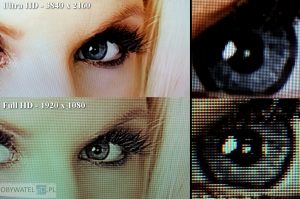So if you’re a media nerd or full-blown techie, you’ll notice that there’s been a lot of buzz surrounding 4K lately. But for those of you who don’t spend hours keeping up with the latest trends, we’re here to give you the basic lowdown. Don’t worry, it’s simple.
What is 4K?
When people talk about 4K, what they’re really talking about is pixels – all of those little boxes that make up images.
All you need to know is that 4K = more pixels. A LOT more pixels.
How much is A LOT exactly?
8 Million!
Full HD images are composed of 1080 pixels (height) x 1920 pixels (width). 4K essentially doubles those numbers so you get 4 times as many pixels. 1 Standard HD image could fit itself 4 times into a single 4K image! Crazy, right?
Wait, does this actually matter? Why do I care about pixels?
YES! You should care because more pixels means more information, which means sharper and better quality images. This is comparable to the jump from Standard Definition to High Definition. Would you like to go back to SD? Yeah, not us either.
So, 4K equals more pixels… But why is it called 4K?
The term 4K reflects the 4,000 pixels lined up horizontally across the image. Makes enough sense, right?
Are a lot of people using 4K?
More and more people are buying 4K TVs therefore several companies are providing 4K content to show off its great picture. Since viewers are increasingly streaming video through online servers directly to their televisions these days, hosts like YouTube, Netflix, Hulu, and Amazon Instant Video all offer 4K content. As its popularity continues to grow, you’ll see this trend continue with even more opportunities to view 4K video.
Where can I showcase my 4K footage?
Larger screens are definitely more effective for exhibiting 4K quality footage. Opportunities like digital signage and trade show displays are compelling marketing tools to utilize 4K footage and engage people with all of that jaw dropping imagery.
Like we talked about earlier though, several online video servers offer the ability to upload 4K footage for streaming. 4K looks just as awesome on your laptop as it does on that giant flat screen TV!
What if I’m delivering my video in HD? Do I really need to shoot in 4K?
Shooting in 1080p to deliver in HD is still perfectly fine. However there are definitely advantages to capturing your images in 4K even if you want to showcase them in Full HD.
Because of the massive increase in resolution, shooting in 4K allows you a lot of flexibility in post production. For instance, you could easily film something in wide shot and adjust frame size later by zooming in during the edit without losing quality. Things like motion tracking, color correction, and noise reduction all become more fine tuned when manipulating 4K footage.
In short, having so much control in post production yields a better final product.
All of this means I should definitely create content with 4K systems?
Even though 4K is still relatively new, it’s definitely working its way toward becoming the industry standard. The good news is that it will be around for awhile and at this point, you’re still ahead of the curve! So if you want the most professional high quality work that you can appreciate for years to come, it’s 4K or the highway.

